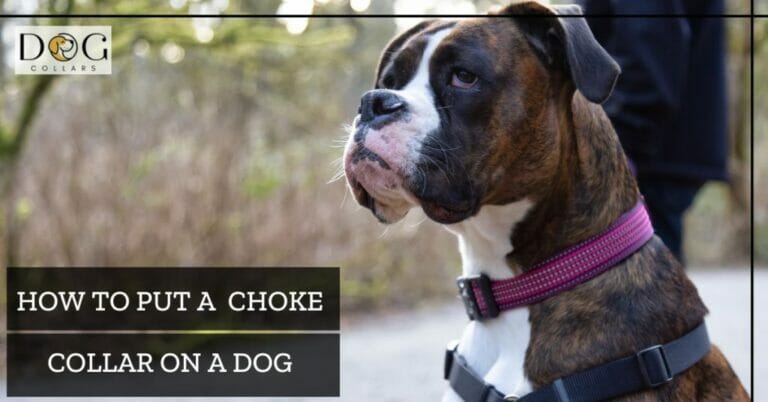Dog Harness vs Choke Collar – Making The Right Choice

Are you caught in a tug-of-war between a dog harness and a choke collar, wondering which one is best for your furry friend?
Dog owners want nothing but the best for their furry friends. When it comes to dog training and walking your dog, choke dog collars and harnesses are two of the most common options in the market
The main difference between dog choke collars and harnesses is, the slip collar provides more control, but it can also be harsh and even painful for your dog. Harnesses, on the other hand, distribute pressure evenly throughout your dog’s body, making them a more comfortable and safer option.
Discover the pros and cons of dog harness vs choke collar as we explore their functionality, various types, and ideal usage scenarios. Make an informed choice that prioritizes your dog’s comfort and overall welfare in this comprehensive guide.
Dog Harness Vs Choke Collar – What’s The Difference Between
When it comes to walking your furry friend, choosing the best dog gear is crucial. Two popular options are dog harnesses and slip collars. The main difference between them lies in their design and how they work.
Dog Harness:
- A dog harness is a supportive device that wraps around the dog’s body, distributing the pulling force evenly.
- It offers better control and reduces strain on the neck and throat area.
- Harnesses come in various styles, including back-clip, front-clip, and dual-clip options.
- They are ideal for dogs prone to neck injuries, those with respiratory issues, or those who pull excessively on the leash.
- Harnesses promote a more comfortable and safe walking experience, allowing better control during training sessions.
Choke Collar:
- A choke collar, also known as a slip collar or training collar, tightens around the dog’s neck when pulled.
- It is primarily used for training purposes and correcting behavioral issues.
- Slip collars should be used with caution and under the guidance of a professional trainer.
- They can potentially cause discomfort, injury, and may increase the risk of neck-related problems.
- Slip collars are generally not recommended for dogs with respiratory or tracheal issues.
Remember, choosing the right equipment for your dog depends on their individual needs, behavior, and comfort.
- Dog Harness
Pros Of Dog Harness
Dog Harnesses are a popular alternative to traditional collars, and for good reason. They offer several benefits for both the dog and their owner.
- Harnesses distribute pressure, avoiding strain on the neck.
- They provide better control and comfort during walks.
- Various designs cater to different activities.
- Harnesses often include ID tag attachments for safety.
- Harnesses offer improved control and safety for training.
- They are especially beneficial for dogs with respiratory issues.
- Choosing a harness ensures comfort and enhanced control.
Cons Of Dog Harness
While canine harnesses have many advantages, they also have some disadvantages.
- Some dogs may resist or chew through harnesses.
- Harnesses may offer less control compared to slip collars.
- Certain types of harnesses can encourage pulling behaviors.
- Attaching an ID tag to a harness may cause discomfort.
- Consider the comfort and fit for different dog breed sizes.
- Proper training methods can maximize benefits and minimize downsides.
- Harnesses require careful selection and consistent training for effectiveness.
Types Of Dog Harness
When it comes to canine harnesses, there are a variety of types available in the market depending on your dog’s breed and size.
Back-Clip Harnesses: Back-clip harnesses have a leash attachment at the back of the dog’s neck. They are great for small dogs or those that don’t pull as much because this type allows more freedom of movement but less control.
Front-Clip Harnesses: Front-clip harnesses have an attachment at the center of your pup’s chest which helps to discourage pulling by gently redirecting them every time they try to pull ahead. It is especially effective for larger breeds who may be difficult to handle on walks.
Dual Clip-Harness: Dual clip-harness features both front and back attachments giving you greater versatility in how you walk your pet. This type combines the benefits of both designs providing control over heavy pulling pets while allowing safe movement during casual strolls or runs.
It is important to remember that not all dogs will respond well to every kind of harness; each one has its own unique benefit and should be chosen only after proper research about what works best with their specific needs.
- Choke Collars
Pros Of Choke Collars
Choke collars, also known as slip collars or training collars do have some advantages in certain situations.
- Slip collars are helpful for dogs that pull or get overly excited.
- They provide a reminder of proper behavior through pressure.
- Owners gain better control over their dogs’ actions.
- Correct use can address unwanted behaviors safely.
- Professional trainers often utilize slip collars with specific breeds.
- These collars are part of specialized training techniques.
- While drawbacks exist, experienced handlers can use them effectively.
Cons Of Choke Collar
Choke collars, also known as slip collars or chain collars, are a type of collar that tightens around the pup neck when pulled. While choke collars may seem like an effective way to train your dog, they come with several cons.
- Choke collars can harm a dog’s health.
- Tightening may cause trachea or neck muscle injuries.
- Inconsistent enforcement due to varying leash pressure.
- Difficulty controlling the force applied during training.
- Choke collars can increase anxiety and aggression.
- Negative behavioral changes may result, such as fearfulness.
- Risks outweigh benefits compared to other options like harnesses.
Types Of Choke Collar
When it comes to choke collars, there are a variety of types of dog collars available on the market.
Prong Collar: One common type of choke collar is the prong collar. This type of collar has metal prongs that dig into your dog’s neck when pulled, causing discomfort and discouraging bad behavior.
Choke Chain Collar: Another popular option is a choke chain collar which features an adjustable loop that tightens when pressure is applied. These collars can be dangerous if not used correctly as they have been known to cause damage to dogs’ tracheas.
Martingale (limited-slip) Collar: A martingale collar is another alternative for those who want more control over their pet without choking them entirely. It works by tightening slightly around the neck but not enough to cut off breathing completely.
While some argue that slip collars are necessary tools for training dogs, others believe they are cruel and unnecessary. Whatever side you fall on, it’s important to research and choose a properly fitting collar based on your breed’s needs and training requirements.
Factors To Consider While Buying Dog Harness Vs Slip Collar
When it comes to choosing between a pet harness and a slip collar, there are several factors that you should consider.
- Breed Considerations:
- Different breeds have different needs and preferences.
- Consider the breed’s size, temperament, and specific requirements.
- Purpose of Use:
- Determine if the equipment is for training or everyday walks.
- Slip collars are often used for training and reinforcement.
- Harnesses are comfortable and safer for walks or runs.
- Durability:
- Look for high-quality materials that can withstand wear and tear.
- Check the strength of the hardware and stitching.
- Comfort and Safety:
- Ensure the equipment is comfortable for your dog to wear.
- Harnesses provide a more comfortable option for walks.
- Collars should not cause discomfort or restrict breathing.
- ID Tag Attachment:
- Ensure the equipment has a place for attaching an ID tag.
- This helps identify your dog if they get lost.
Whats Better Option Dog Harness Vs Slip Collar
When it comes to choosing between a dog harness and a slip collar, there is no one “better” option. It ultimately depends on the individual needs of your dog and its breed.
For dogs that tend to pull or have respiratory issues like collapsing trachea, a harness may be the better option as it distributes pressure evenly across the chest instead of placing pressure on the neck.
On the other hand, some trainers believe that slip collars can provide necessary reinforcement for certain breeds during training sessions. However, they should only be used under close supervision and with proper technique to avoid injury.
Both options have their own set of pros and cons. It’s up to pet owners to do their research and make an informed decision based on what works best for their furry friend.
Conclusion
when considering the choice between a dog harness vs choke collar, it is crucial to prioritize your dog’s comfort, safety, and specific needs.
A canine harness offers better control, and comfort, and is suitable for everyday walks and activities, particularly for dogs with respiratory issues or a tendency to pull. On the other hand, a slip collar can be effective for training purposes when used correctly and under professional guidance.
However, it is important to note that slip collars can pose risks to your dog’s health and may not provide consistent reinforcement. Ultimately, it is recommended to consult with a professional trainer or veterinarian to determine the best option for your dog, considering their breed, behavior, and training goals.
FAQs
Can you use a harness instead of a collar for your dog?
Yes, you can use a harness instead of a collar for your dog. In fact, many dog trainers recommend using a harness because it can give you better control over your dog without putting pressure on their neck.
Should you use a collar or a harness for a puppy?
It is generally recommended to use a harness instead of a collar for a puppy, as their neck and body are still developing and are more fragile than those of adult dogs.
How do you train your dog to not pull on a leash with a harness or collar?
One method to train your dog not to pull on a leash is to use positive reinforcement, rewarding your dog when they walk without pulling. Another option is to use a no-pull harness or a head collar that provides more control over your dog’s head and neck.
Can a harness prevent a dog from slipping out of it?
Yes, a properly fitted harness can prevent a dog from slipping out of it, especially if it has a back-clip or dual-clip attachment.








